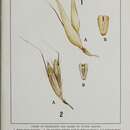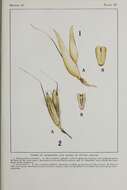Description: Memoir 10 Plate III 2 TYPES OF SPIKELETS AND BASES OF OUTER GRAINS 1, Avena sativa orientalis. A, the complete spikelet, with its glabrous lemmas and reduced awns; B, base of the outer grain, showing its non-articulate surface and its rhachilla from which the inner grain easily separates 2, Avena brevis. A, the complete spikelet, showing toothed projections of the lemma; B, base of the outer grain, showing its non-articulate surface and its rhachilla from which the inner grain easi'v separates. Date: 1916. Source:
https://www.flickr.com/photos/biodivlibrary/17842561113. Author: Cornell University.; Cornell University. Full titleMemoir. Page ID47179216. Item ID181400 (
Find related Wikimedia Commons images). Title ID50893. Page numbersPlate III. NamesNameFound:Avena brevis NameConfirmed:Avena brevis EOLID:5816011 NameBankID:10749387 NameFound:Avena sativa orientalis NameConfirmed:Avena sativa var. orientalis (Schreb.) Alef. EOLID:1114783 NameBankID:1733188. BHL Page URL
https://www.biodiversitylibrary.org/page/47179216. Page typeIllustration. Flickr sets Cornell University Agricultural Experiment Station - Memoir. Flickr tags Agriculture Harvard University Botany Libraries bhl:page 47179216 dc:identifier
https://www.biodiversitylibrary.org/page/47179216 Avena sativa orientalis Avena brevis harvard university botany libraries. Flickr posted date4 June 2015. Credit
: This file comes from the
Biodiversity Heritage Library. This tag does not indicate the copyright status of the attached work. A normal
copyright tag is still required. See
Commons:Licensing.
Deutsch |
English |
español |
français |
italiano |
日本語 |
македонски |
Nederlands |
polski |
+/−. Licensing[
edit] : This file is licensed under the
Creative Commons Attribution 2.0 Generic license. :. You are free: to share – to copy, distribute and transmit the work to remix – to adapt the work Under the following conditions: attribution – You must give appropriate credit, provide a link to the license, and indicate if changes were made. You may do so in any reasonable manner, but not in any way that suggests the licensor endorses you or your use. https://creativecommons.org/licenses/by/2.0 CC BY 2.0 Creative Commons Attribution 2.0 truetrue. This image is in the
public domain because it is a mere mechanical scan or photocopy of a public domain original, or – from the available evidence – is so similar to such a scan or photocopy that no copyright protection can be expected to arise. The original itself is in the public domain for the following reason: Public domainPublic domainfalsefalse. : This work is in the
public domain in its country of origin and other countries and areas where the
copyright term is the author's life plus 70 years or fewer. This work is in the
public domain in the
United States because it was
published (or registered with the
U.S. Copyright Office) before January 1, 1926.
This file has been identified as being free of known restrictions under copyright law, including all related and neighboring rights.. https://creativecommons.org/publicdomain/mark/1.0/PDMCreative Commons Public Domain Mark 1.0falsefalse This tag is designed for use where there may be a need to assert that any enhancements (eg brightness, contrast, colour-matching, sharpening) are in themselves insufficiently creative to generate a new copyright. It can be used where it is unknown whether any enhancements have been made, as well as when the enhancements are clear but insufficient. For known raw unenhanced scans you can use an appropriate
{{PD-old}} tag instead. For usage, see
Commons:When to use the PD-scan tag. Note: This tag applies to scans and photocopies only. For photographs of public domain originals taken from afar,
{{PD-Art}} may be applicable. See
Commons:When to use the PD-Art tag.



